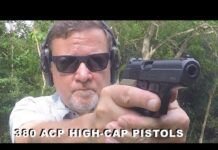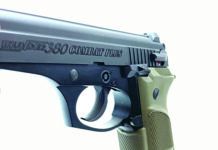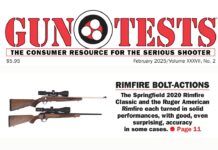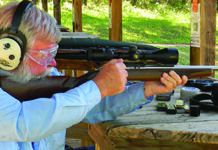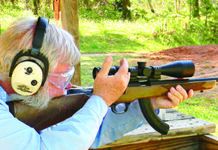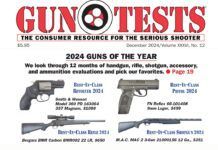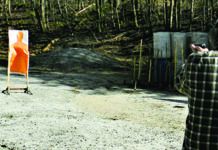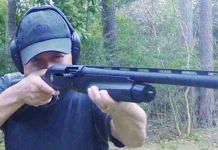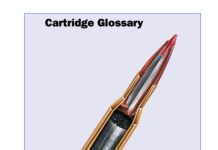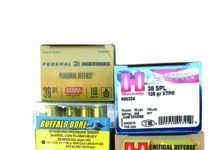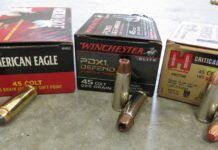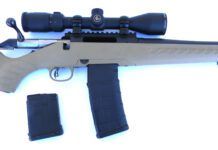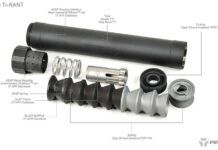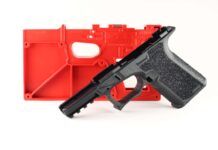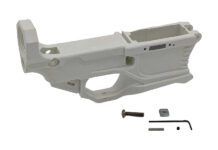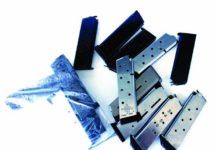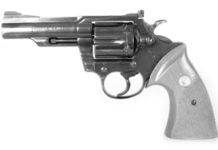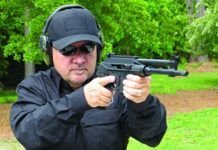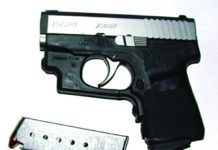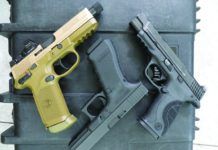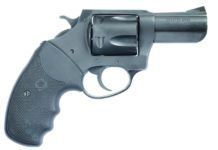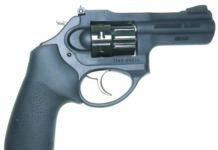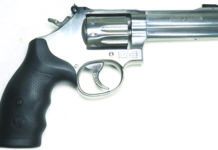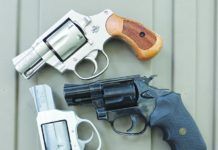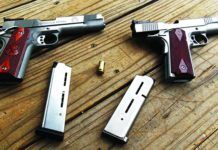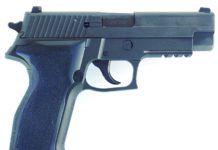1911 Magazines: Some Are Good, And Some Should Be Avoided
Magazines for the 1911 pistol have evolved more during the past two decades than during any other time since the pistol's introduction. The bane of the 1911 is cheaply made magazines, with poor ammunition close behind. For many years, the only choices were Colt factory magazines, which were usually high quality, then GI magazines, and poorly made gun-show magazines. Some were marked COLT 45 on the base in bold letters, and these usually meant the shooter was the real deal. At a time when new Colt magazines were around $15, aftermarket magazines sold for as little as $4, and most of them were not worth the aggravation. GI magazines were good quality, but shooters often found them bent and worn out, unless they were new in the wrapper. Quite a bit of barrel feed-ramp polish and tuning of extractors went on that probably was tied to ammunition and magazine problems. Some of the aftermarket magazines were not properly welded. In other cases, the follower was too tight in the magazine body; and in other instances, the magazine springs were weak. Others had poorly attached buttplates, that gave way when dropped on the ground during IPSC competition. Some survived, others did not.
The basic construction of the magazine itself has changed from sheet steel to aluminum and plastic followers versus metal followers. We have examined quite a few magazines that invited a situation called false slide lock. The follower appeared to catch the slide lock, but the slide lock was actually on the wrong shelf, which isn't good for any of the parts. A 1911 feeds by the loading block on the bottom of the slide stripping the cartridge forward as the slide moves forward. The cartridge case rim catches under the extractor and is pressed forward. Some feel that it is a good thing that the bullet nose snugs a little over the feed ramp and bumps the cartridge case head into the breech face as the cartridge enters the chamber. Some magazines, notably the Wilson Combat, allow the bullet nose to strike much higher on the ramp, which results in missing the feed ramp's edges more so than others.
…
Colt Trooper Mark III .357 Magnum
The Colt Trooper was made from 1953 to 1969. The Trooper Mark III superceded the Trooper and had a redesigned lock mechanism. It was manufactured from 1969 to 1983 in blue and nickel finish with 4-, 6-, and 8-inch barrel lengths. An owner's manual can be obtained by calling Colt at (800) 962-2658. The Trooper III in our test was made in 1974.
The Colt Trooper Mark III is for all practical purposes the working man's Python. Sound good? It features a serrated front sight pinned in place. The rear sight is fully adjustable, and it should be more durable than similar designs since the rear notch moves back and forth inside a protective frame. While adjustment for elevation is clockwise for down and counter-clockwise for up, the windage adjustment is reversed. Turn it to the right if you want the point of impact to move left, and turn left to bring the POI to the right.
Another feature is the direction in which the cylinder rotates. While other revolvers move counterclockwise, expecting a Colt to go bang requires the first round to be in the 11 o'clock position prior to cycling. Also, to release the cylinder one pulls rather than pushes on the latch.
5.56mm Pistols from Kel-Tec, Spikes Tactical, and CMMG
It could be argued that the AR pistol evolved out of a desire and need for shooters to own a legal short-barrel rifle-caliber weapon without having to jump through BATFE hoops or pay for a tax stamp to own an SBR (short-barreled rifle). The difference between an AR rifle and pistol comes down to the pistol not being compatible nor able to attach a stock. We wanted to take a look at these AR pistols for home defense and other uses where a compact firearm makes sense, because they offer a number of benefits over a conventional AR rifle, mainly, being more maneuverable while being chambered in a rifle caliber and being compatible with common AR-15 magazines. We acquired three examples, a Spike's Tactical The Jack custom build, a CMMG Mk4 K, and a Kel-Tec PLR-16. The Spike's and CMMG are true AR-15 mechanisms reconfigured to a pistol, while the Kel-Tec uses a different operating mechanism. All three are chambered in 5.56mm NATO/223 Rem. and all are compatible with AR-15 magazines.
We tested these pistols for accuracy, performance, reliability, compatibility with a range of AR-15 magazines, maintenance, ability to be customized, and cost. We found that the Kel-Tec was inexpensive compared to the CMMG and Spike's Tactical pistols. The Kel-Tec, however, needed to be operated differently. The CMMG and Spike's were an easy transition from AR rifle to AR pistol. An AR pistol, as we found out, is nearly as effective as a full-size AR at close to mid range. With the right ammunition, they could be tuned to be a very capable home-defense choice for anyone in the family competent to operate a firearm. Namely, using frangibles to limit overpenetration through walls and doors while still supplying lots of pop.
The AR pistol's edge is its size, but it is also a disadvantage, as an AR pistol is not as easy to shoot as a rifle or a traditional handgun. They are large and require two hands to effectively deliver accurate shots. You could get off a few shots holding an AR pistol with one hand, but the weight of the pistol causes muscle fatigue. A typical full-size handgun may weigh more than 2 pounds loaded, compared to these AR pistols, which weighed from 3.2 to 6 pounds unloaded. Add a pound or more for a 30-round magazine, and you've got a sidearm that would wear out nearly anyone who didn't transport them with a sling, just as you would with a rifle. We used one of the SIG SBX Pistol Stabilizing Braces ($149; SIGSauer.com) and found we liked to use the brace differently than intended, which we will get into shortly.
We also fired the pistols using a Blackhawk Storm Sling ($33.95; Blackhawk.com), a single-point sling with a built-in bungee cord, which many team members felt was an excellent way to carry and control the pistol. We tested with three different AR-15 magazines, including a Brownells USGI CS (Brownells.com; $14) constructed of aluminum, and two polymer magazines, the Magpul PMag Gen2 (Brownells.com; $12.30), and the FAB Defense Ultimag (TheMakoGroup.com; $25). For fast reloads, we also used a Kydex AR magazine carrier from IBX Tactical (IBXTactical.com; $35).
Building an AR pistol is not just a matter of installing a short barrel in a upper receiver and swapping out the receiver extension/buffer tube. Short barrels lose velocity and provide less dwell time for the projectile, so manufacturers need to tune and time the mechanism. A short barrel also needs to work on a range of loads from low- to high-quality ammunition. Reliability can be an issue.
Hands down, the CMMG and Spike's offered more customization than the Kel-Tec because they are compatible with a range of AR-15 aftermarket products — triggers, rails, pistol grips, BUIS, and more. The Kel-Tec is not as compatible. Also, for those testers already familiar with an AR-15, the CMMG and Spike's were much easier to maintain. But there's much more to consider, which we relate below:
Folks Liked the 380 ACP Review
While you didn't like the sights, short grip, or the long DAO trigger of the Kahr CW380, I loved all of them when comparing this gun to the others available at the time, especially the long smooooooth trigger. What a wonderful trigger the Kahr has! Once I bought it, I began adapting it to my own needs and use. First, I added two additional magazines and a pair of Pearce grip extenders, then added a Hogue rubber grip. The Pearce grip extenders allow me to get all three fingers on the grip, and the Hogue makes it extremely comfortable. Next I added a Crimson Trace laser for low-light situations. Now, I have what I consider to be a perfect pocket pistol. It is invisible in a pocket holster. Sorry to disagree, but IMHO, the LCP doesn't come close to my Kahr. I suggest everyone adapt whatever they buy/use to their hands, eyes, stance, needs, and abilities to maximize its utility. Then practice, practice, and practice.
Optics-Ready: M&P9 Ported, FNX-45 Tactical, G17 Gen4 MOS
If there is one new trend taking hold of pistol manufacturers, it is making optics-ready pistols. These handguns come out of the factory with the ability to mount a reflex-style red dot sight. The newest is the Glock G17 Gen4 MOS, which debuted in 2016. Kahr, SIG, and the Canik from Century Arms may also see optics-ready models in 2016. Custom gun makers have been crafting pistols with reflex sights for years, and back in 2012, both S&W and FN launched optics-ready pistols. Just like Picatinny rails have emerged as a widespread feature and laser pointers are being offered on many handgun variants, the optic mount is the next evolution of the handgun. We have seen this same scenario play out with AR rifles, where optics were once an anomaly and they are now the norm. Why? Ease of aiming and faster target acquisition. What, perhaps, has slowed the trend is cost. Reflex sights can add anywhere from $240 to $600 extra, depending on the sight. There may also be a need to purchase a new holster to accommodate the optic on the handgun and taller iron sights. This seems a little odd to us because many shooters might consider the cost to be excessive on a handgun, but we don't think twice about mounting a high-quality optic on a rifle. There is no doubt that in the same situations, red-dot reflex sights allow users to aim faster and easier compared to iron sights. Also, reflex sights allow users to aim with both eyes open, peering through a small glass lens that the sight uses to project a reticle onto it via a light-emitting diode. The sight provides an unlimited field of view since there is no magnification and no tube, so tunnel vision is less of an issue when aiming. Also, there is also no need to align three planes — target, front sight, and rear sight — as with iron sights. However, during testing, we found that taller iron sights that co-witnessed with the red dot were preferred because they can help find the dot. Also, BUIS are there in case the optic fails or the battery dies when we need it most. A proper maintenance schedule can alleviate this concern. To see how various red dots could be mounted and used on factory optics-ready pistols, we acquired a Glock G17 Gen4 MOS, an S&W M&P9 Performance Center Ported model, and an FN America FNX-45 Tactical FDE. The Glock and S&W were 9mm striker-fired pistols that are well known to us. We have reviewed numerous Glock G17 models over previous model generations, but this is first G17 Gen4 MOS that our testers have evaluated. The same is true with the S&W M&P9. We have tested other variants of the M&P9, but this is a first for the S&W M&P9 Performance Center Ported model. The 45-caliber FNX-45 Tactical is also new to our testers. What we were looking for with these optics-ready pistols was ease of installation, accuracy, ease of use, and durability.
Snubbies, the Taurus Recall, and Trump on Guns
Regarding the Taurus settlement and the problems Lou had with his pistol: On August 4, 2015 I sent Taurus my PT-111 Pro and two magazines. Their website was very poor about updating progress of the return, but by 12/16/2015 I did have a new PT-111 G2 with two mags, all new in the box. I had to pay $25 for the FFL transfer fee, but I was reimbursed by 1/15/16. I am actually quite pleased with the new gun. To get reimbursed, I faxed an itemized receipt to Taurus at (305) 624-1126. I hope this helps Lou and perhaps others.
Ruger LCRx 5435 22 LR
Taurus 992 Tracker 2-992049 22 LR/22 WMR
Smith & Wesson Model 617-6 160584 22 LR
$400 Snubnose Revolvers: Rossi, RIA, and Charter Arms
We felt all of these were well made, and we believe these revolvers will perform their designed task of self defense. They are also safe to carry fully loaded and concealed, since they are equipped with internal safety systems that require the trigger to be pulled fully to the rear to fire a round. If accidentally dropped, none of them will fire.
Snubnose revolvers like these three offer the user simplicity since there are no manual safeties, magazine-release buttons, slide stops or any other controls on the revolver other that the cycler latch. There is no magazine to lose since the revolver feeds off an attached cylinder. The double-action trigger pull on all three revolvers provided enough resistance — some were easier to press than others — so that in a high-stress situation, we felt they would be quite adequate and be less likely to be accidentally discharged.
All were metal-frame revolvers chambered in 38 Special and sported 2-inch barrels. The Rossi and Charter Arms models have 5-round capacities, while the RIA can carry 6 rounds. Because we also wanted to carry these revolvers, we looked at spurless and concealed-hammer models, which were the RIA and Charter Arms, respectively. The Rossi was a traditional SA/DA revolver with an exposed hammer with spur.
After running these revolvers, we found we liked a lot about all of them, but, as always, we noted some specific details about them we did not like. Our biggest gripes were the trigger pulls and grips, as we note below. Accuracy with some of these short-barrel protectors was a pleasant surprise.
All three were marked 38 Special, and we read the manuals to see if the guns were safe to use +P ammo. The Rossi manual stated it was compatible with +P ammo, but not to use +P frequently. We decided to test with 38 Special regular-pressure ammunition only, and acquired some Federal Champion 158-grain lead roundnose (LRN) cartridges, some Armscor 158-grain Full Metal Jacket (FMJ) rounds, and Hornady Custom fodder loaded with 158-grain XTP hollowpoints. Felt recoil with this ammunition varied widely.
A $400 revolver will exhibit some characteristics, such as fit and finish, that are not going to be nearly as nice as a revolver costing twice as much because finishing a firearm can be labor intensive and costly. What we concentrated on were the functional aspects: triggers, sights, grips, accuracy, concealability, and ease of use. Here is what we discovered.
Practical Target Guns: Kimber And Springfield Go Head to Head
In this installment, we pit two practical target guns against each other. By practical target guns we mean accurate and useful 1911 handguns suitable for personal defense, hunting, and some forms of competition. They are not so specialized that they are not holster guns or unreliable for general use. Some target guns simply are not as robust as these handguns.
Fragile sights that overhang the slide too far, as an example, are counterintuitive in an all-round packing gun. If an adjustable sight loses its zero in competition, you will lose the match. Losing zero in a personal-defense situation carries a stiffer penalty for failure. Getting down to the nitty-gritty, fiber-optic front sights are not always desirable in a hard-use handgun because they tend to be fragile, even if they deliver superior targeting performance.
On the other hand, a service pistol or a hunting pistol with adjustable sights is desirable given the wide range of bullet weights and velocity available with the 45 ACP cartridge.Gun Testsreaders already know that the 1911 Government Model platform is a versatile, go-anywhere do-anything handgun; but the question is, can target performance translate to defensive reliability and handling?
When the National Matches got into full force after World War One, improvements were undertaken on the 1911 handgun. Barrels were welded up and carefully fitted, and high-profile sights were fabricated. These improvements led to the Colt National Match pistol's introduction in 1933. The National Match featured a hand-honed action and two-way adjustable sights. Law officers and outdoorsmen also adopted this relatively expensive handgun. Changes and modification led to the Colt Gold Cup. The sights were fragile in many renditions — not the case in the newest models — so the shooter wishing to own a service-grade handgun with target sights had to take the custom route. Expedients, such as fitting Smith & Wesson revolver sights to the 1911 slide, were not always successful, but the Bo-Mar sight was an excellent addition to any 1911.
High-visibility adjustable sights are a good thing to have, provided they are reliable in keeping zero, are not fragile, and aren't likely to be damaged. Today, we have the best adjustable-sight 1911 pistols yet from the factory, and our two tests guns put them to excellent use. Here's how they performed.
40 S&W Shoot Out: Beretta, CZ-USA, Ruger, and SIG Sauer
Pistols chambered for the 40 S&W round often are the odd man out as the first choice of a citizen contemplating arming himself or herself. Most of us choose the 45 ACP for its terminal performance and the 9mm Luger for capacity. Here, though, this report is in part a continuation of 40-caliber ammunition tests we conducted some years ago. One of our raters has much field experience and favored the 45 ACP and did not give the 40 S&W much attention.
After empirical testing, he came to the conclusion that the 40 is more like the 45 than the 9mm in terminal ballistics, and that's a good place to be. This rater also tested compact and subcompact 40-caliber pistols and came away believing that forties lighter and smaller than the Glock 23 are too much for most shooters to handle well. So, it was logical that he gravitated toward service-size 40 S&W handguns as the right fit of cartridge and pistol.
Full-size handguns are among the most common 40 S&W handguns chosen for home and personal defense. They are relatively mild to fire and reliable.
With these facts in mind, we wanted to test four 40-caliber handguns of different configurations to see which one suited our testers the best. Also, we went looking for value, shooting two brand-new guns against veterans which, perhaps, still had some game left in them. The two new guns were a selective-double-action CZ 75B and the double-action-only Ruger SP40, which we found listing around $580 and $569, respectively. The other choices were the double-action first-shot SIG P226R and the double-action first-shot Beretta 96 Vertec Inox, the latter a used model and the former was a factory rebuild offered by SIG Sauer.
The Beretta Model 96 Vertec has received praise from us before, being named a Gun of the Year in 2005 after being evaluated in the April 2005 issue. We said then, "Alloy 40 S&W pistols have a well-earned reputation for packing plenty of power in their lightweight frames, but they are also well-known for being vicious kickers for the training shooter. However, the Model 96 Vertec was an exception." In particular, we liked the vertical grip design that, combined with the thinner grip panels and short-reach trigger, made the pistol much friendlier to shooters with smaller hands. We liked it because its flat-sided feel and more rectangular shape were easier to index, that is, get in proper alignment faster. This time we tested the stainless version.
Certified Pre-Owned SIG Sauer pistols like the P226R tested here are often traded in by law-enforcement agencies for new SIGs, and the company puts the pre-owned SIG pistols through a stringent Factory Certification process. Each pistol is stripped, refitted with original factory parts where needed, cleaned, lubricated, function tested and hand-inspected by a factory technician. Each Factory Certified pre-owned SIG comes with a one-year warranty and one standard-capacity magazine. The condition of these pistols will vary depending on the amount of wear, such as that caused by a holster and ring wear, and that condition will be reflected in the retail price. Dings and holster wear and ring scratches are not covered under the one-year factory warranty.
We tested a similarly set up CZ 75Bpreviously (May 2009), but chambered in 9mm. In that test we noted the accuracy of the CZ was about 2.5 inches for all shots fired at 15 yards. We also noted the heavy CZ dampened 9mm recoil, and there were no problems with the CZ whatsoever. It appeared to be very well made and built to last. We looked forward to testing the 40 S&W version.
Likewise,we tested a Ruger SR40previously, most recently in the October 2011 issue. In that review, we said, the SR40 was remarkably underrated, and it might be a plastic gun for people who don't like plastic guns. We said, "Its slender profile makes it more controllable than most high-capacity guns, and it's a good candidate for concealed carry, too. We liked having manual safeties even if they weren't perfect. Though not match grade, we thought the trigger was predictable with a reasonable sense of take-up and overtravel." That model was the BSR40, with an all-black color scheme and a 15+1 capacity, which is now listed by the company as Model 3471. This new SR40 is Model 3470, still with the same 15+1 capacity, but this time with a brushed-stainless-steel slide.


